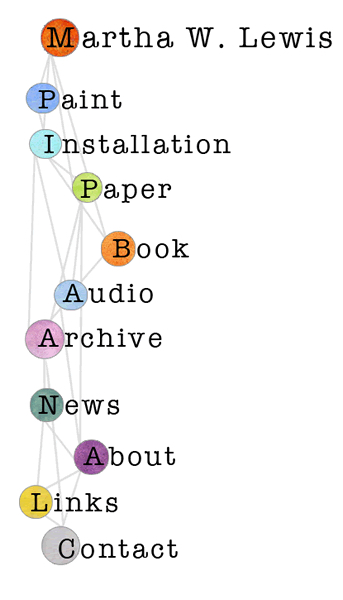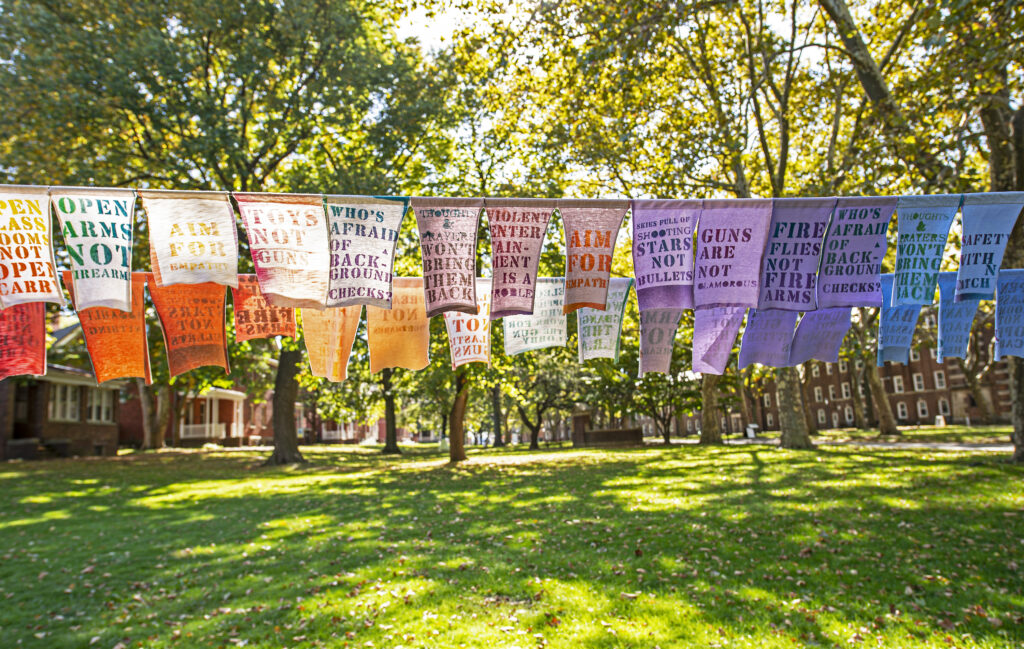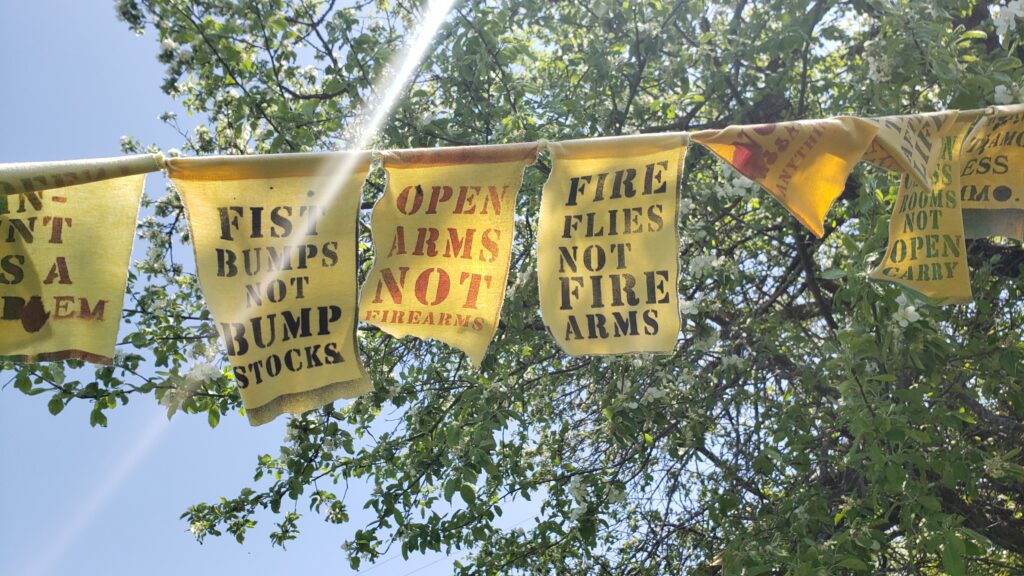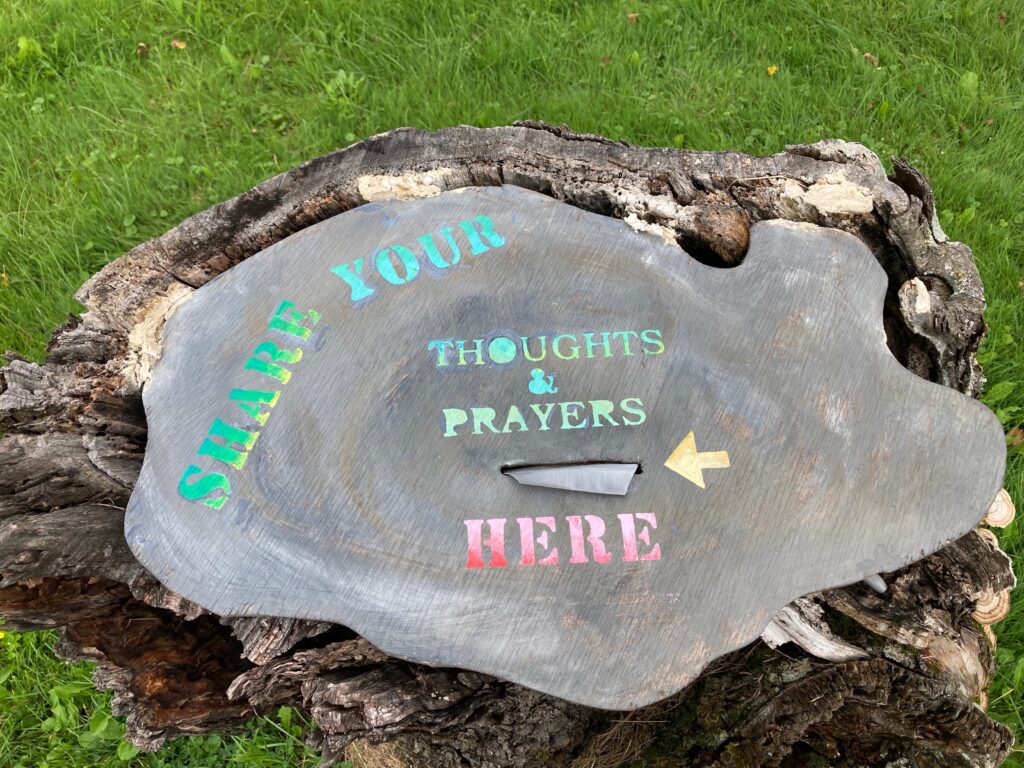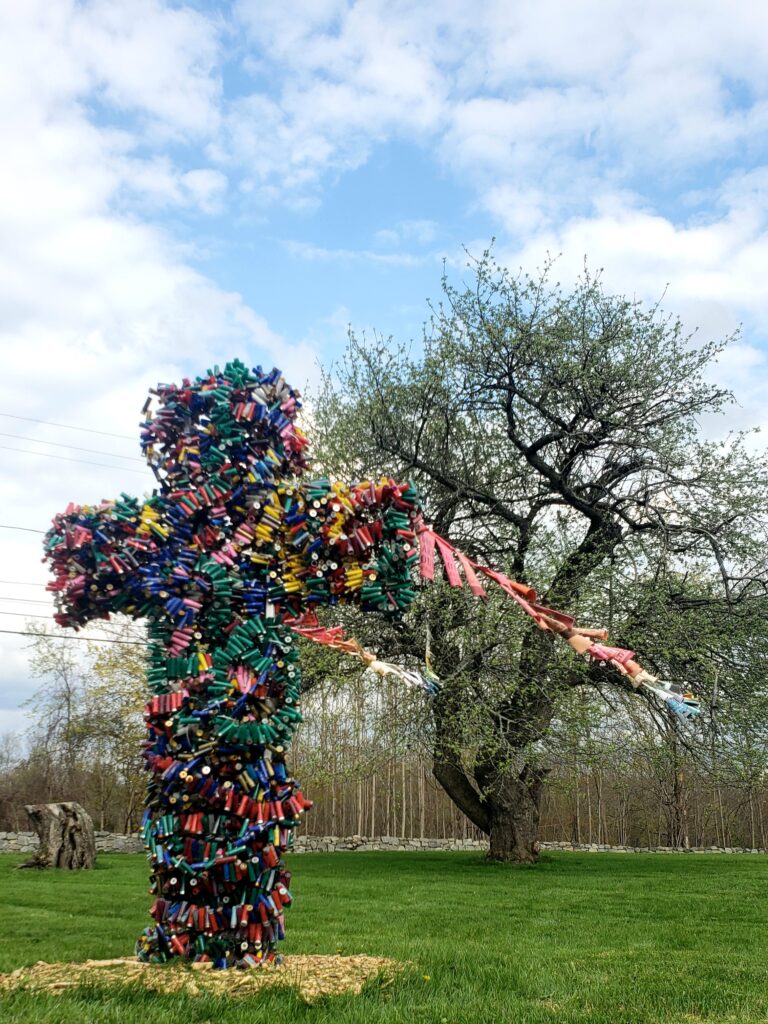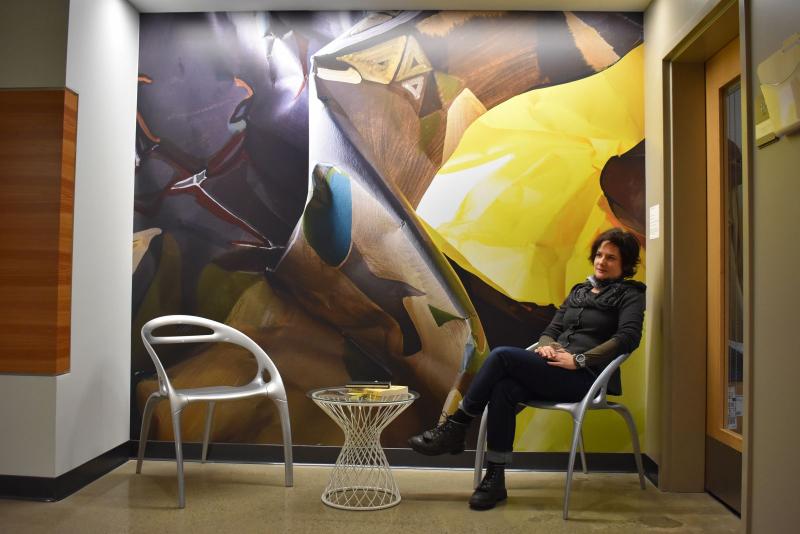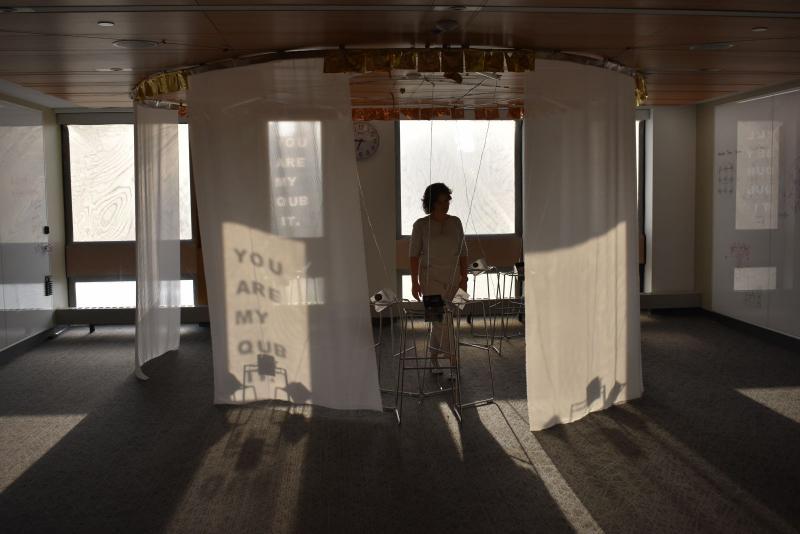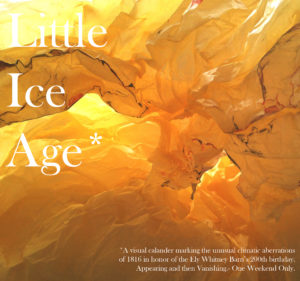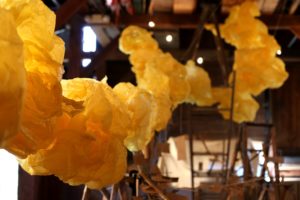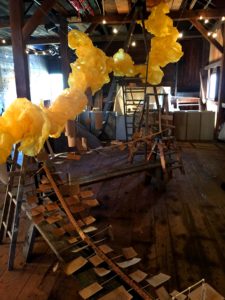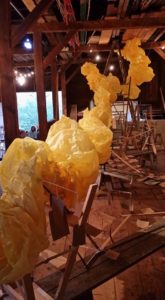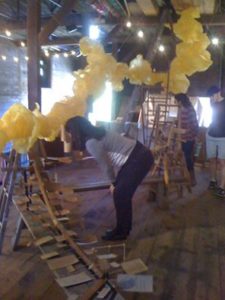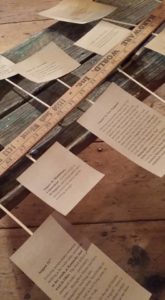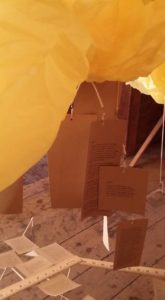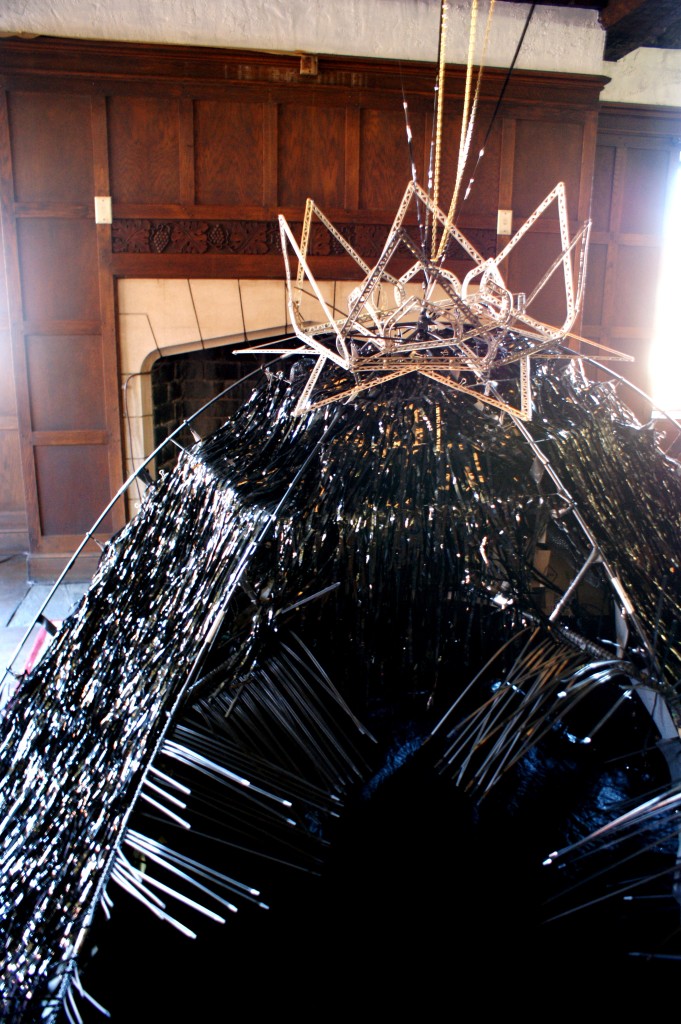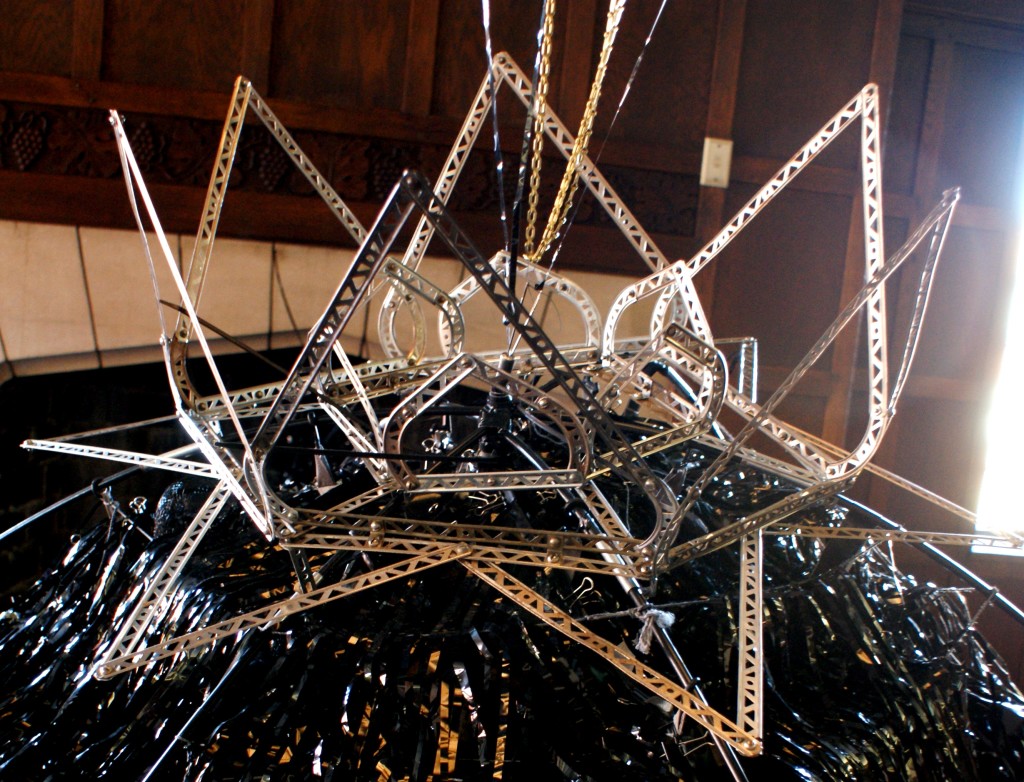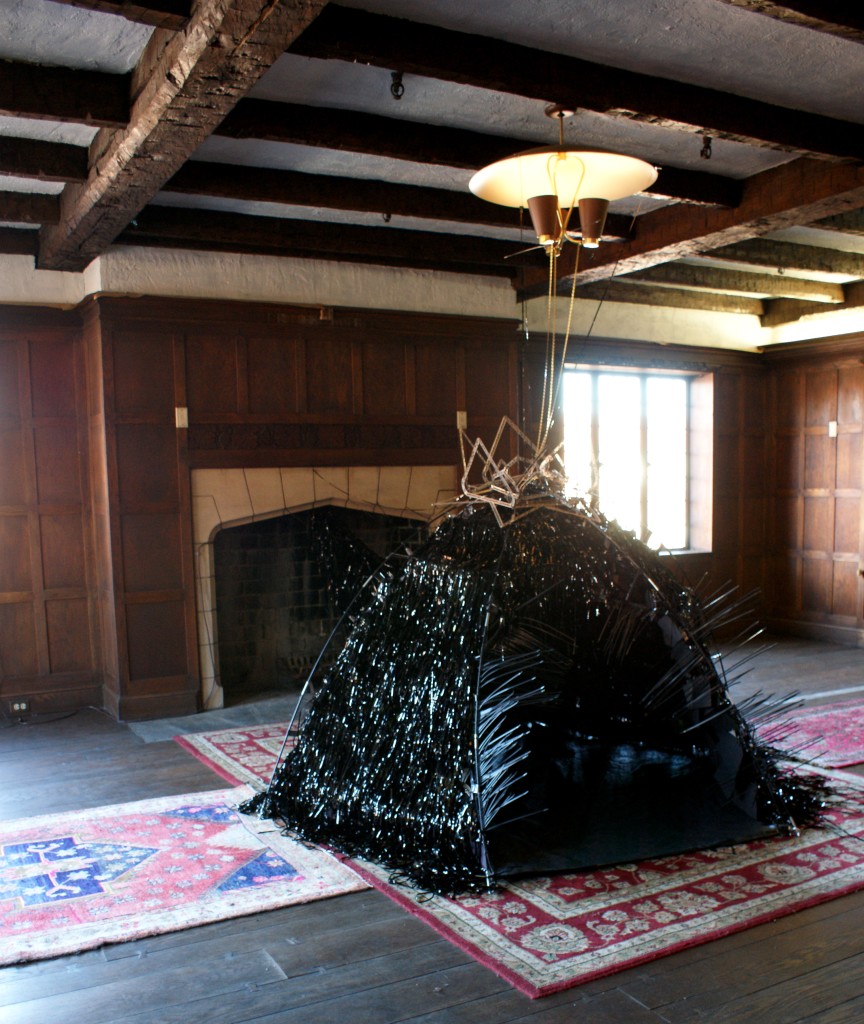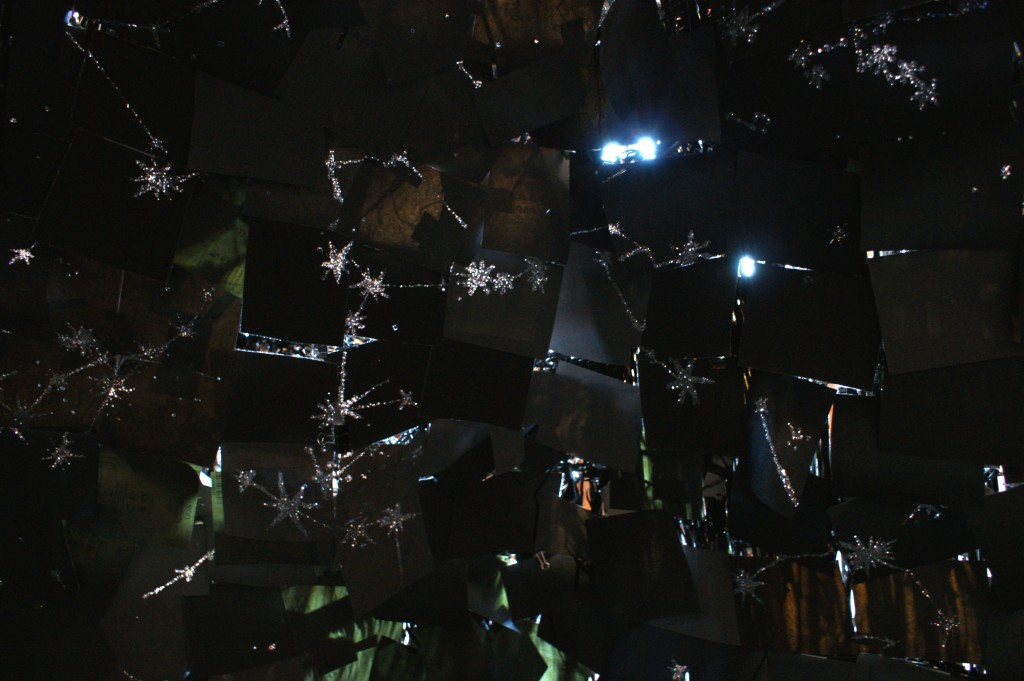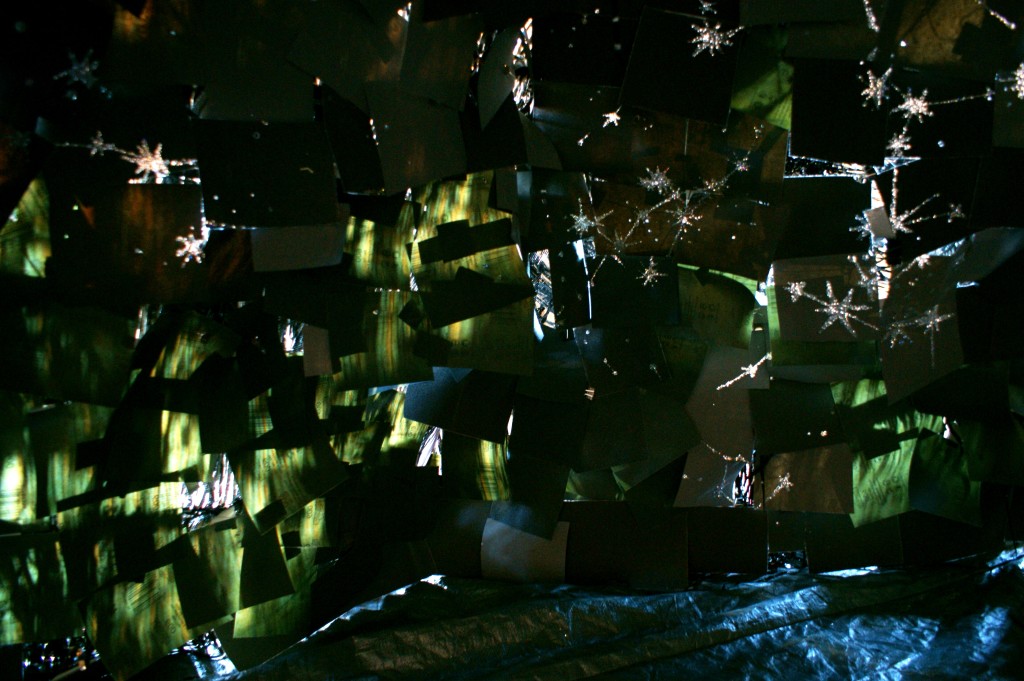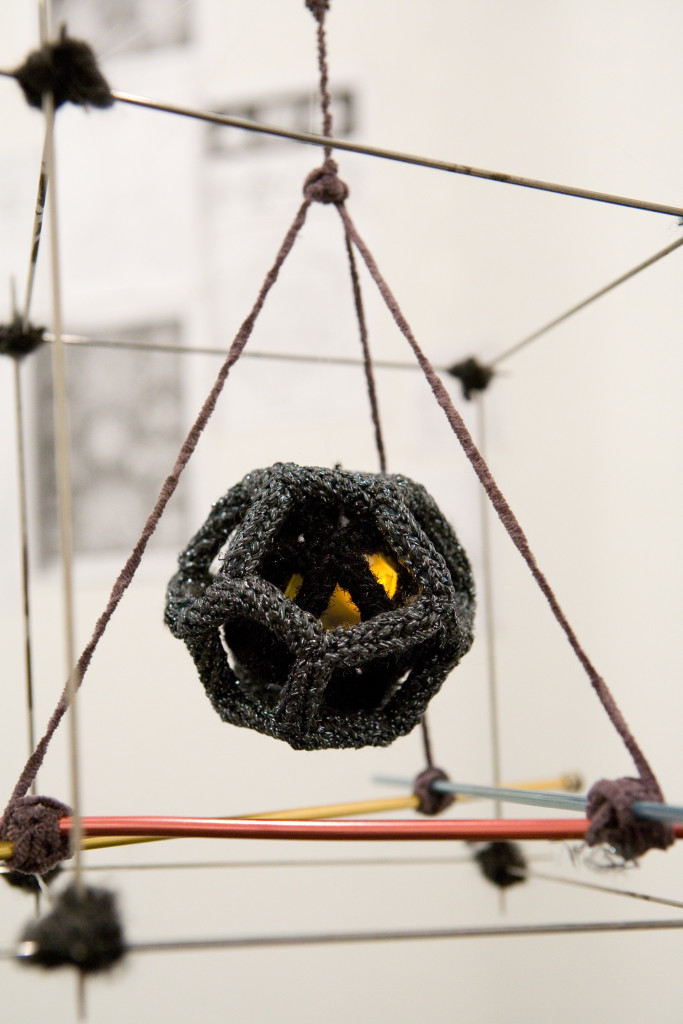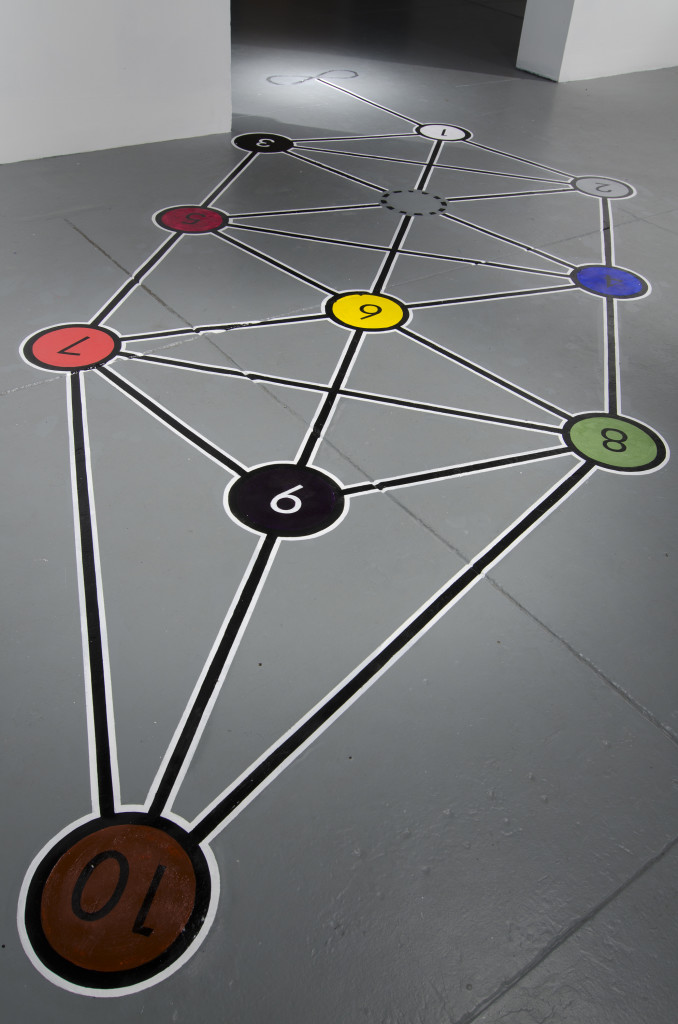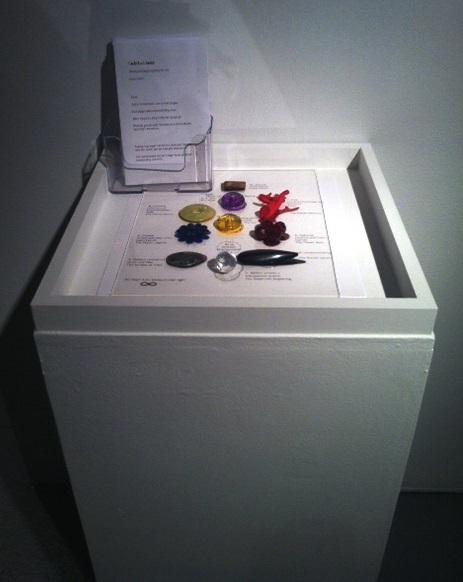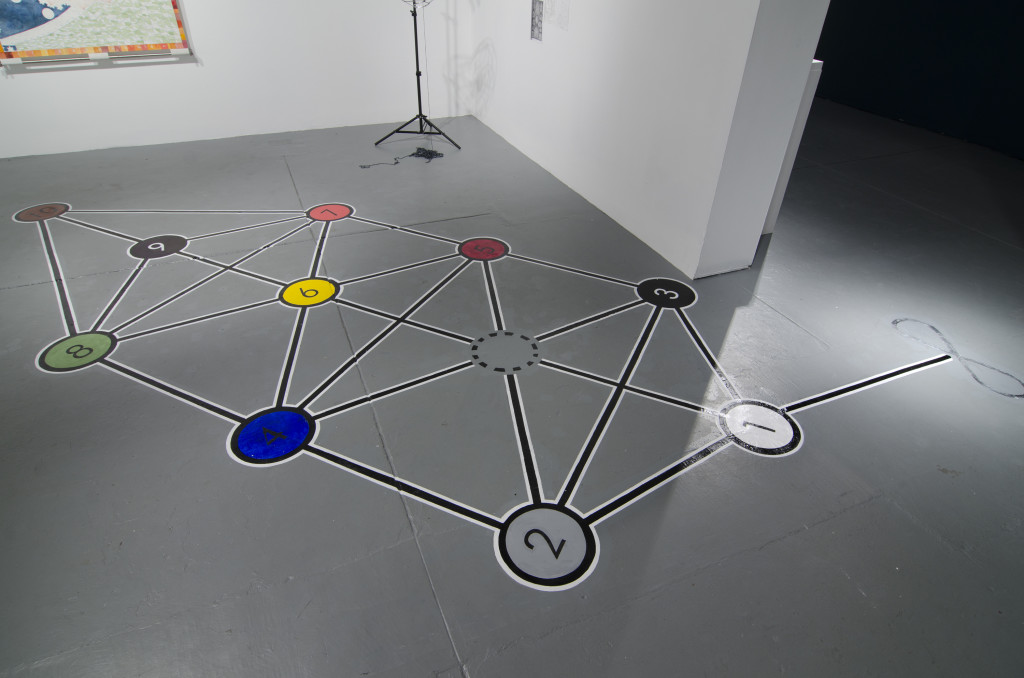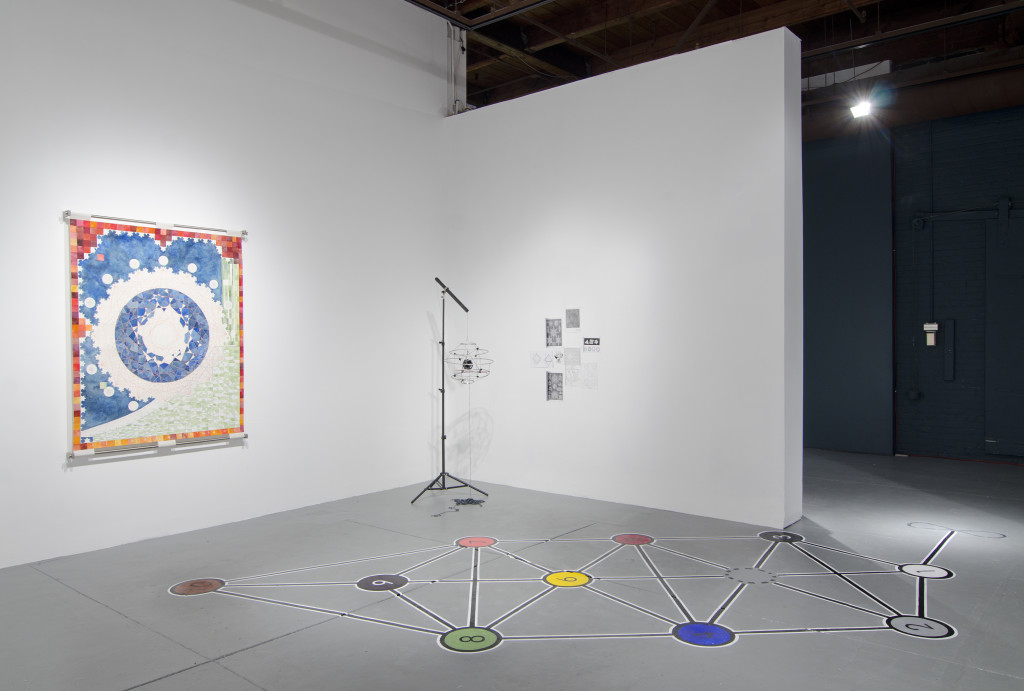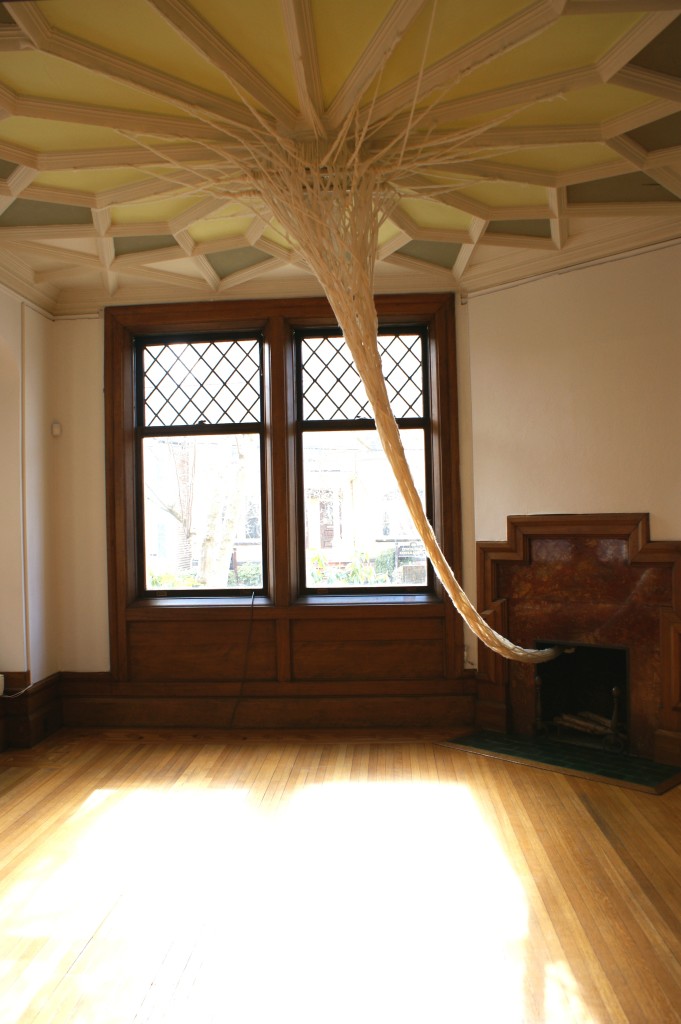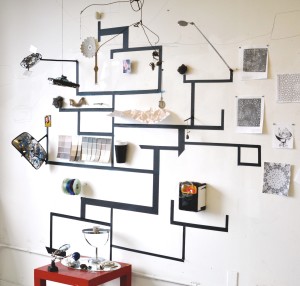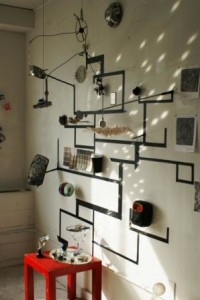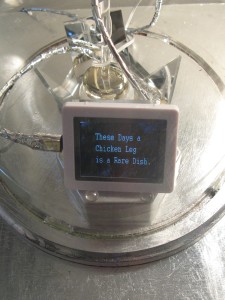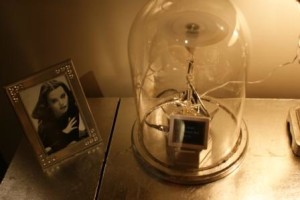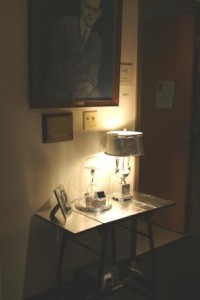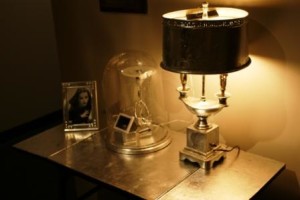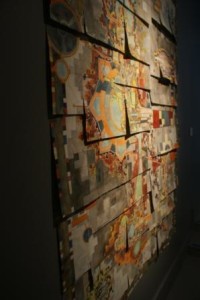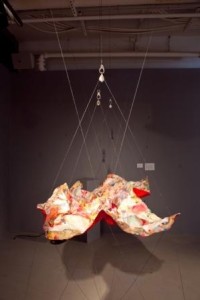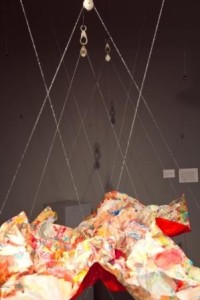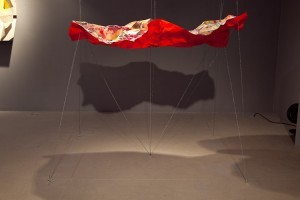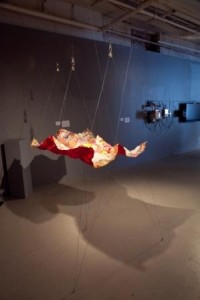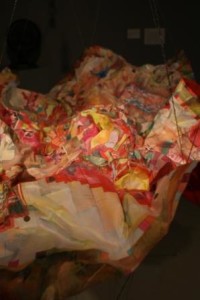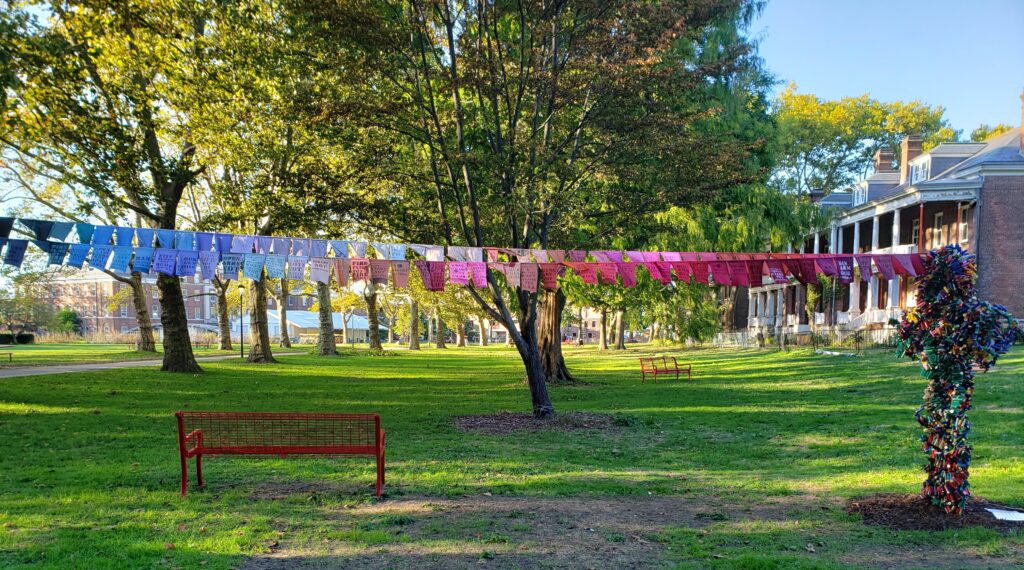 Thoughts & Prayers is a collaborative outdoor installation by artists Margaret Roleke and Martha Willette Lewis, addressing gun violence in America. Now on display on the campus grounds at Five Points Arts Center, this piece made its debut in the fall of 2022 on Governor’s Island, NYC where hundreds of visitors interacted with it. Margaret & Martha’s goal is to have Thoughts & Prayers tour the country, installed in various civic spaces, to help incite better conversations about our collective relationship to weapons and violence in the United States.
Thoughts & Prayers is a collaborative outdoor installation by artists Margaret Roleke and Martha Willette Lewis, addressing gun violence in America. Now on display on the campus grounds at Five Points Arts Center, this piece made its debut in the fall of 2022 on Governor’s Island, NYC where hundreds of visitors interacted with it. Margaret & Martha’s goal is to have Thoughts & Prayers tour the country, installed in various civic spaces, to help incite better conversations about our collective relationship to weapons and violence in the United States.
The large, cruciform structure was built by Roleke who painstakingly threaded, then wrapped dozens of used shotgun shells around the armature, to create a colorful, texturally rich take on the Christian cross. The prayer flags were made by Lewis, using crowd-sourced tee shirts hand-cut and stenciled with her custom messages. Every flag contains human DNA, signs of wear and a past as the covering on a human torso. They act as fluttering surrogates, protesting and bearing witness to each weaponized incident.
Similarly, Roleke’s shells- sourced from various rifle ranges- bear the marks of human touch and interaction- they are often bent and misshapen by use. Like Lewis’ flags, they appear in a candy-colored array, giving the work a polychromatic, full-spectrum presence, further evoking the vivid diversity of us, here in the USA.
Two lines of prayer flags extend from the shoulders of the sculpture, flying 12 feet over to a neighboring tree. The tree is important as a living, thriving organism, connecting to the deadly cruciform structure via a series of short missives about gun violence, collective action, hope and survival. Thoughts & Prayers is a sentiment frequently issued by public figures wishing to signify piety and concern while also signaling an unwillingness to act on gun-control.
Traditionally, Prayer flags are hung outside in the Himalayas to promote peace, compassion, strength, and wisdom. Tibetan Buddhist culture believes that the prayers will be blown by the wind to spread these characteristics out into the world, for the benefit of everyone. As they weather and age, new ones are hung to purify the air with their messages.
The Latin Cross is a religious symbol echoing the human body, and redolent of the pain and suffering of Jesus Christ. Once an instrument for public torture, it is now commonly used as a grave marker, and as a somber symbol of piety by Christians.
Trees are used symbolically throughout the religions of the world, frequently representing spiritual nourishment, transformation, liberation, union and fertility. A particular tree is often the center of paradise or exists on several planes at once as the axis mundi. They are often seen as sacred and containing spirits and knowledge.
Roleke & Lewis believe in and respect the power inherent in images and symbols. Thoughts & Prayers is a gesture towards bringing people of all faiths and belief systems together in the common goal of addressing gun violence. Accompanying the installation is a site, located in an adjacent tree stump, where the public can share their own messages about gun control and gun violence. These may be added to future iterations of the project, shifting the voice of the project to a collective chorus.
Do YOU have a site for Thoughts & Prayers to visit?
Please email Martha with suggestions.
Martha was the initial artist-in-residence at the Yale Quantum Institute in New Haven. For that year-long project she who created several quantum inspired art pieces in collaboration with YQI researchers.More about her time at YQI can be seen here:
https://art.quantuminstitute.yale.edu/Artists/Martha.html
Her final work during the residency was the interactive and immersive installation “I’ll be your qubit!” where the visitor was invited to experience the world within a quantum circuit at the human scale. this Large Scale, Multi- Media Installation was a part of The International Festival Of Arts & Ideas and included public tours of the artwork, a panel discussion, and takeaway souvenirs.
Martha has continued to partner with YQI which has led to The Quantum Revolution, and exhibit at The New Haven Museum featuring her drawings of the experiment fridges, historic artifacts gathered and presented during her stay and Badger, The first experiment “fridge” to have ever run a successful quantum experiment. this exhibit included a talk, tours and a lavishly illustrated catalog.
Little Ice Age: A Visual Calendar
Mixed media installation for the Eli Whitney Barn, Hamden, CT. Approximately 40 feet long and 15 feet high. Vintage and modern Ladders, twine, paper, wooden benches, c-clamps, Yardsticks, wood, 2016
Little Ice Age: A Visual Calendar was a data-driven Site-specific work marking the unusual climatic aberrations of 1816 in honor of the historic Eli Whitney Barn‘s 200th birthday. The installation consisted of a “Sulfur Cloud” of crushed yellow architectural trace emitting from the top of a giant ladder volcano and leading visitors through the year 1816 – the year the barn was constructed – month by month. Yardsticks were used to measure off the days and months with labels marking entries for the days taken from the text. The Little Ice Age refers to the period of time from 1300 to1870 when the earth went through a cooling period, partially due to various volcanic eruptions.
The most dramatic example was the year 1816 after the eruption of Mount Tambora in Sumatra, causing a sulfur cloud to travel the world creating what was called in Europe and north America The Year Without a Summer. The impact of the drastic weather coupled with other factors including the end of the Napoleonic wars created a moment in time where crop scarcity, economic collapses and the lack of government social services created a crisis, and with crisis comes a radical change for the survivors. In the years that followed there was an exodus from the North East of as Americans moved west, and in turn, immigrant Europeans arrived in America.
This project marks this passage of events in the United States and Western Europe. Eastern Europe, Asia, and Africa are not included here in the interests of keeping the project to a manageable scale. That does not mean they did not suffer- people and animals died directly from the eruption, the molten lava, and the boiling seas, not to mention the thick ash and pumice that choked the land and seascapes for miles. Tsunamis, Typhoid epidemics, and starvation afterward were three of the direct results.
Much of the project used text and quotes from the excellent book: The Year Without Summer: 1816 and the Volcano That Darkened the World and Changed History by William K.Klingaman and Nicholas P.Klingaman, published St. Martin’s Press. This book includes a wealth of letters, diary entries, and newspaper clippings which I used as sources. There were several excellent reviews of the installation, readable here and here: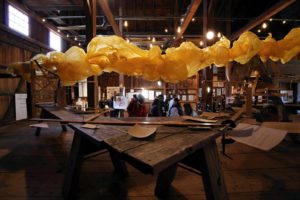
The Method of Loci: a Primordial Memory Palace
2015, Site-Specific Mixed Media installation (commissioned by Artspace, New Haven for Dwelling Themed City-Wide Open Studios Festival)
The Method of Loci was a site-specific installation occupying the office of Mr. A.C. Gilbert, in Erector Square, the former headquarters of the A.C.Gilbert Company and factory for the Erector set. The office, which was installed in 1923, is normally closed to the public. The Method of Loci used the historic building as its starting point, constructing a rudimentary planetarium in the center of the office.
The Method of Loci consists of a tent-like structure occupying the central axis of the room and creating a temporary sacred kiva to spatially invoke, simultaneously, micro and the macro-cosmic, via a kind of rustic planetarium. The dark interior, which visitors are be invited to cautiously enter, creates a meditation chamber with glittering galactic drawings that are dimly visible, shimmering and rustling subtly.
Martha has had a studio at Erector Square since 2007 and is fascinated by the building and the history of the Gilbert Company. Read more aboutThe Method Of Loci Here
Mysterium Cosmographicum Falsigraphia
2012, 2011 and 2009 Mixed- media work: Angora, wool, lurex, and polyimide yarns, aluminum knitting needles, vintage steel knitting needles, fishing hooks, aluminum stand, photocopies, stolen cable wire (industrially knit metal), paper, light bulb, tape and cardboard.
Mysterium Cosmographicum Falsigraphia is a work based on Johannes Kepler’s theory of our solar system being organized by platonic solids. This model was laid out in his book from 1600, the Mysterium Cosmographicum . He believed he had found God’s geometrical plan for the universe. His combination of reasoning, hard science, and mysticism intrigued me- the parts that he got wrong as much as what he got right.
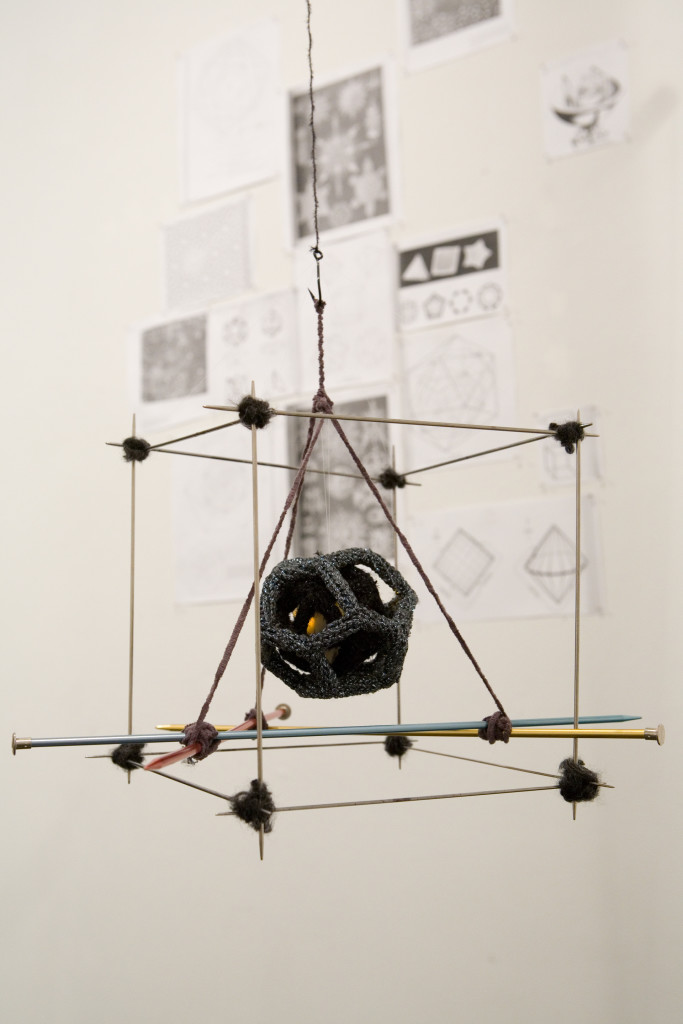
Falsigraphia is the medieval term for the then-rampant genre of “false diagrams”. “False model” might be a more accurate description for this piece. Mistaken beliefs, misjudged imagery, and inaccurate lines of reasoning often attract me as much as correct observations, rigorous logic, and timeless clear-sightedness. The process of discovery itself is bound to be full of errors, and erring is a profoundly human attribute. Raveling and unraveling the mysteries of our universe, and the pitfalls inherent in this process are the impetus behind this work.
When Mysterium Cosmographicum Falsigraphia was shown at Greenwich Academy in 2011, one of the students wrote a poem about the work- read it here.
T.O.E./T.O.L. (Theory of Everything/Tree of Life)
2012, Hand-painted floor game, with gems for throwing. Shown here installed as a part of the exhibition Diagram, at Real Art Ways, Hartford, CT.
Theory of Everything: A concept which will bind together particle physics, relativity and string theory into one cohesive whole.
Tree of Life:
a diagram from the Kabala, adopted by the Rosicrucians, alchemists and many others. It is most striking as it functions on a macro level as an explanation of the origins of the universe, as well as on a micro level as a meditation on the development process of individual life. The image/name of the “Tree of Life” appears again and again in differing contexts throughout world mythology, religion and origin stories, it is also related to evolutionary diagrams, family trees and other sorts of lineage tracing documents, as it records both familial relationships and the implied passage of time.
About Hopscotch:
A very old game played throughout the world to differing names and rules, our version comes from the ancient Romans and was first used as a military exercise, much the way obstacles are used in contemporary football training. Hop is obvious; Scotch refers to escotche or scratch, as one does to make the diagram.
To Play: one tosses a gem onto the first number and hops onto it, continuing forward and back until all of the stages of development and the creation of the universe are complete.
pdf of the full rules
Ligeia
2012, A site-specific work created for the exhibition Exploded Views, at the John Slade Ely House Gallery in New Haven. The title refers to a story by Edgar Allen Poe about a man whose preternaturally strong-willed wife returns from the dead, after he has elaborately redecorated his castle in her memory.
mixed media installation with buffalo and sheep wool roving.
Model for a Celestial Wunderkammer,
2011, Mixed media installation.
The images shown here are a mock-up for a large-scale project. The Celestial Wunderkammer is a temporary collection of models for explaining celestial phenomena. Most discussions about the universe use metaphors and analogies to explain concepts and processes that are difficult to grasp. Stephen Hawking employed at least 74 everyday analogies in his book A Brief History Of Time to explain astrophysics and quantum theorem. Imagining the workings of a clock helped Johannes Kepler develop his ideas of planetary motion. In turn, this model of a clockwork cosmic system is essential to understanding the Enlightenments’ structural concept of nature, God, and the world surrounding us. For Steinhardt and Turok, our entire universe is a sheet of paper blowing in the wind, a kind of two-dimensional membrane (The “Brane”) tumbling through a four-dimensional background called “the bulk”. Barbour’s “Nows” (time as a constant unit) can be imagined as pages of a novel ripped from the book’s spine and tossed randomly onto the floor, each page is a separate entity. And so on.
This project visually describes our search, past and contemporary, to explain our cosmos, our origins, and the multi-verse in all its bewildering complexity. Competing theories and obsolete ideas co-exist side by side on the makeshift “shelves” of the cabinet. Unlike much of physics, space exploration, and scientific practice, this project is inexpensive, disposable, and inclusive. The cabinet’s objects are stand-ins for valuable, impossible-to-get items and phenomena, many only theoretical. Such topics as scale, flow of time, the big bang, string theory, the color of the universe, the current version of our solar system can be envisaged here, using pieces of paper, sea sponges, cups of coffee, paint sludge, rising bread dough.
The Message is a Medium,
2010, Site-specific mixed-media installation in the Museum of Discovery, at the Haskins Language Lab in New Haven, CT. This work was created as a part of the exhibit Mindsets. Motor, plastic, tape, glue, putty, glass, wood, wire, solar panel, lamp, silver leaf, photocopy of Hedy Lamarr, Digital images, office furniture, electricity.
This work was based on the contextual apparatus surrounding the Pattern Playback Machine located in the “Museum of Discovery” at Haskins Lab: namely the history as described on the website and the “museum” itself, which features the actual device plus portraits of the scientists and various framed images, plaques, and other bits of documentary evidence related to the machine. The “Adventure Film”, a vintage black and white TV clip available for viewing on the website, showing the machine and its’ scientists,with it’s awkward format and deadpan camera work defined the aesthetic of this installation.
I found, in the website text, the tantalizing suggestion that previously there were other, different versions of the machine, but that this one was the remaining sole survivor. This got me into speculating (my work here is much more about rumor, speculation and superstitious belief than it is about scientific fact. I leave fact and conclusions to the scientists.) The idea that there were other variations really fascinated me and I started to work less rational, more haunted versions…
The Pattern Playback Machine converts pictures of the acoustic patterns of speech back into sound. My version plays with the code-speak aspect in those strange sentences the machine echoes back. They sound like spy-talk from a cold-war era film, and seem rife with implied meaning. Just reading those sentences stopped me in my tracks: the huge possibilities for mis or re-interpretation and other-worldly high-jacking of the machine’s very pragmatic and noble purpose overwhelmed me.
I ended up by conflating three different real-life histories: firstly, that of the Playback Machine itself, secondly, that of Hollywood actress and inventor Hedy Lamarr, whose coding device, a form of “spread spectrum communication” is still in use today, and thirdly, the apocryphal story of Thomas Alva Edison’s alleged invention of a “machine to talk to the dead” which could communicate with ghosts. He was playing a joke on a reporter when he mentioned this idea, but, like much wishful thinking, it hardened into a true rumor, with people searching for the patent drawings and surrounding its “disappearance” with conspiracy theories.
The original machine’s relationship to ghosts, television and cinema, as well as glamorous (female) inventors seemed a rich mine to delve, and the fictions just created themselves. The actual physical make-up of the playback machine intrigued me: it’s home-made and hand made qualities and the odd materials it uses- foil, mercury light bulbs, transparent acetate sheets, white paint, some sort of resinous disk. They seemed so unlikely, so illogical…
By inserting the installation into the Museum, where it exists as a sort of false artifact-also offered the opportunity to insert a woman into the male-dominated world presented by the Museum of Discovery.
Plan B: Stirring Of Melts Using Rotating And Traveling Magnetic Fields,
2009, Watercolor and pencil on cotton paper, digital print, lurex string , steel pulleys and weights, acrylic paint, cardboard, electric fan. (Installation commissioned by Artspace New Haven for the exhibition: The Weekend Inventor.)
Plan B consists of a large format digital printout of a watercolor painting. It is on crisp coated paper that has been crumpled into a topological format with valleys and hills. This is then positioned horizontally and is suspended, floating between floor and ceiling.
The piece is free-standing, meant to be walked around.
A small strategically placed fan vibrates the strings so that the whole work wobbles and shimmies. The original painting, from which the print was made, is hung on the adjacent wall alongside a small map folded work which hangs on the wall half-open. The large piece on the wall flutters much more gently, breathing in and out, while the smaller satellite work on the wall contains its own housing it can fold up into, reducing it size by half.
Additionally, the fan provides a sort of ambient rumbling soundtrack to the work.
A short video of the piece is available here.
A review of the exhibit may be found here.
